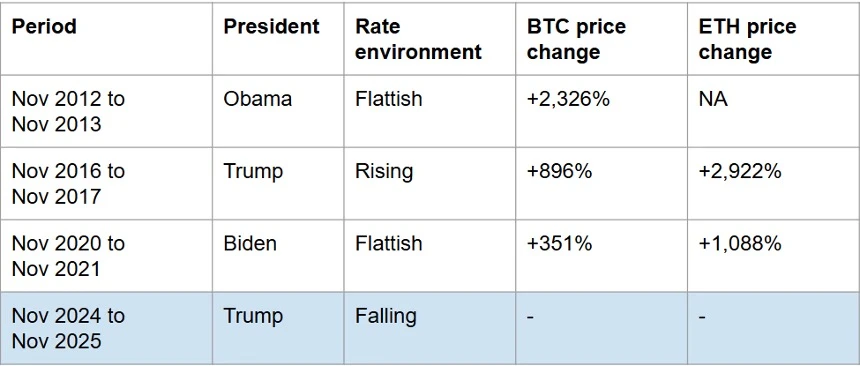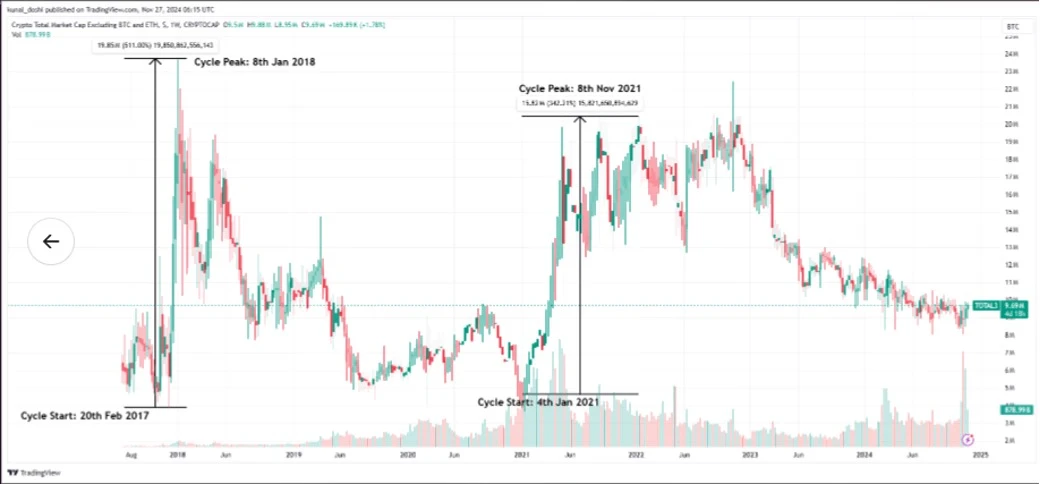Original title: Republican Victory Ushers in a New Era for Crypto
Original article by Kelvin Koh, Spartan Group
Original translation: Odaily Planet Daily Husband How

The 2024 US presidential election has become one of the most watched elections in recent years. Although most people expected the election to be extremely fierce before the election, the results still surprised many people. Not only did Trump win the presidential election in a convincing way, but the Republican Party also won a majority in the Senate and the House of Representatives. Such an overwhelming victory will give the Republican Party enough political leverage to promote multiple changes in the next few years. The cryptocurrency field is expected to usher in major changes, and we believe that the next 12 months will be a favorable period for crypto assets.
One thing that is different about the 2024 election is that there is a crypto agenda in this election, and the winning president and his core advisory team are friendly to cryptocurrencies. Cryptocurrency companies have strongly supported Trump and key Republican candidates through donations. Therefore, it is not surprising that the crypto industry has become one of the main beneficiaries of this Republican sweep.
There has been a lot of discussion about what this election means for the crypto industry, but here are a few of the main impacts:
Changes in SEC policy. Under Gary Gensler, the SEC and other appointees of the Biden administration have implemented aggressive regulation of the crypto industry. Despite repeated calls from the industry for regulatory guidance, the SEC has insisted on managing through enforcement actions. During Genslers tenure, more than 2,700 enforcement actions were initiated and fines totaling $21 billion were issued. This has made it difficult for many projects to do business in the United States. Trump made it clear during the campaign that he would replace Gensler if elected. Sure enough, last week Gensler announced that he would resign as SEC Chairman on January 20, 2025. Several candidates have been nominated to take over, and they are generally seen as more supportive of the crypto industry. This means that existing enforcement actions may be rescinded and the SEC will take a more collaborative regulatory approach.
Improvement of the Congressional environment. In the past, one of the challenges facing the crypto industry was that it was difficult to pass any favorable bills in the U.S. Congress because most members either lacked understanding of cryptocurrencies or did not understand them. However, after this election, about two-thirds of members of Congress are considered pro-cryptocurrency. This will likely bring about a regulatory framework that supports innovation, making it easier for projects to raise funds, and clearing the way for institutional capital to enter the crypto space.
The proposal for a strategic bitcoin reserve. During the campaign, Trump told his crypto supporters that if elected, he would push for the establishment of a strategic bitcoin reserve rather than letting the U.S. government continue to dispose of previously seized bitcoins. This proposal quickly gained traction after the election. If this proposal is realized, the market will begin to speculate whether this means that the U.S. government will become a net buyer of bitcoin rather than a seller. If MicroStrategy alone can affect the price of bitcoin, imagine the impact of the U.S. government establishing a strategic bitcoin reserve. More importantly, how will other countries react to this? Will they also come up with similar plans?
DeFi support. Even before the election, the Trump-backed team launched World Liberty Financial in September 2024, aiming to provide decentralized lending services and achieve governance through the native token WLF. The project has raised more than $50 million to date, with the latest investment coming from crypto entrepreneur Justin Sun, who invested $30 million this week. WLF plans to raise a total of $300 million. Whether it eventually raises 300 million or 50 million, the significance of this project is far greater than its amount - it provides great encouragement to DeFi developers and innovators. More importantly, this DeFi project supported by the incoming US president will have a profound impact on the entire industry.
Each of the above events is enough to have a significant boost to the crypto market, but the combination of these events has a far-reaching impact on the crypto industry. The market has not yet fully reflected the potential impact of these changes, which is why the US media called this period the golden age of crypto.
In addition to all of the above, Trump has also expressed his desire to make the United States the “crypto capital of the world.” In some ways, the United States is already the de facto crypto leader. Many major infrastructure projects, some of the largest blockchain infrastructure companies, and decentralized applications have their origins in the United States. The United States also has the world’s largest licensed cryptocurrency exchange, the largest crypto investment bank, and the largest pool of Web3 venture capital. In addition, the United States accounts for about 40% of the world’s Bitcoin mining computing power (compared to 17% in 2021), becoming the largest center for Bitcoin mining, thanks in part to China’s policy changes. Most of the world’s crypto transactions are also denominated in US dollars, and major stablecoins are pegged to the US dollar. Therefore, the United States is already the global crypto center in many ways. However, if the US government plans to consolidate or further expand its dominance, what does this mean for other governments, especially major financial centers such as London, Tokyo, Dubai, and Hong Kong? More importantly, can Europe afford to miss the cost of the Web3 innovation era and fall behind again after the Web2 era?
Some may question whether Trump will actually follow through on these promises, but I think the odds are good that he will. Trump doesn’t play by the rules, and the political leverage that comes with this election victory is strong. In addition, Trump has two crypto native advisors around him, Elon Musk and JD Vance. New Commerce Secretary Howard Lutnick is also the chairman and CEO of Cantor Fitzgerald, which just acquired a 5% stake in Tether, the issuer of the world’s largest stablecoin USDT. Add to that a friendlier, pro-crypto Congress, and it shouldn’t be hard to push these initiatives forward.
Historical data: Crypto prices perform strongly in the 12 months after the US election, with altcoins outperforming Bitcoin
In the above context, it is particularly important to discuss the impact of all this on crypto asset prices. As can be seen from the table below, historically, the 12 months after the US election is usually a period of strong performance for crypto asset prices.
There are two main observations here:
Regardless of who wins the presidential election and the interest rate environment, crypto assets have performed very well in the 12 months following the US election. We attribute this to two factors:
a) The clarity brought by the election results and the optimism about the new government;
b) The continued momentum of the Bitcoin halving cycle/crypto cycle.Altcoins (represented by ETH) have returned about 3x as much as Bitcoin in the 12 months following the past two elections.
As of 30 days after the 2024 election, Bitcoin is up 46% and Ethereum is up 58%. We believe there is still significant upside over the next 11 months.

To better understand the opportunities for altcoins, lets look at the chart below, which shows the performance of altcoins relative to Bitcoin. As you can see, there are stages in the cycle where altcoins outperform Bitcoin by a wide margin. We call these stages altcoin cycles or altcoin seasons. The last major altcoin cycle occurred in January 2021 and peaked in November 2021. The previous cycle began in February 2017 and peaked in January 2018.

It is worth noting that these altcoin cycles roughly overlap with the 12-month period following the election. We believe the main reason is the strong price performance in the first few weeks after the election and the shift in investor sentiment towards risk appetite. In addition, this trend has attracted retail money into the crypto asset class, which tends to prefer riskier small and mid-cap coins as they are not subject to the liquidity constraints of institutional investors. In addition, altcoins tend to underperform at this point in the cycle, making their risk-reward ratio more attractive compared to large-cap coins. This is also the case in this cycle.
If this historical relationship holds true, then we should expect the altcoin season to begin soon.










